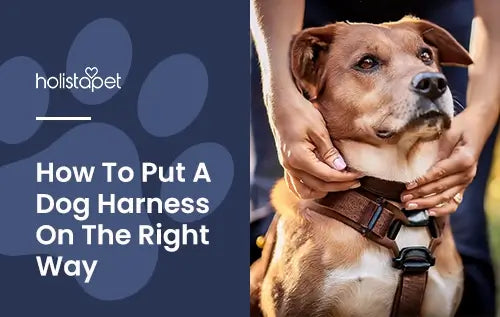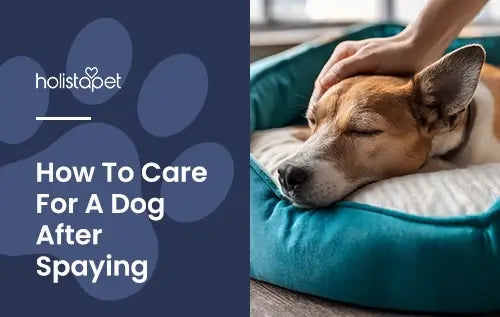Getting ready for an adventure with your furry friend? Learning how to put on a harness on a dog might seem tricky at first, but with the right steps, it's a breeze! A harness is more than just a stylish accessory; it's a key to keeping your pup safe and comfy during walks.
Knowing how to properly fit a harness can help you and your pup enjoy totally stress-free strolls. Let's get started with this guide and make harness time a piece of cake!
What Is a Dog Harness and How Does It Work?

A dog harness is like a special suit for your pup, offering comfort and control all in one. Unlike a traditional collar, a harness distributes pressure evenly across your dog's body, helping reduce strain on the neck. This makes it perfect for pets that tend to pull or are prone to throat issues.
Harnesses come in all shapes and sizes, but they all have one job: to keep your dog safe while giving you more control. With a snug fit around the body, a well-fitted harness can make your outings fun, secure, and comfy.
Why Using a Harness Is Important for Your Dog's Safety
A harness is a must-have for keeping your dog safe during every walk. Unlike collars, which can put pressure on your dog's neck, a harness spreads that tension across their chest and body. This support helps prevent injuries, especially for those energetic pups who love to tug.
A harness gives you better control over your dog's movements, too. Whether you're guiding a large breed or keeping up with a speedy small dog, a harness helps your furry friend stay safe, secure, and ready for every adventure.
Benefits of Using a Dog Harness
Using a dog harness brings tons of perks. Here are some key benefits that make it a must-have:
- Helps Reduce Neck Strain. Harnesses distribute pressure across your dog's body, protecting their neck.
- Provides More Control. A harness gives you better control over your dog, making walks smoother.
- Has Multiple Leash Attachments. Harnesses offer versatile leash attachment points, whether it's a front-clip dog harness for training or a back-clip dog harness for relaxed strolls,
- Helps Prevent Slipping. A snug, well-fitted harness keeps your pet from slipping out.
- Ensures Style and Safety. With various designs, your dog can look good while staying safe.
Related Post: Dog Harness vs Collar: What's the Best Fit for Your Pup
Choosing the Right Harness for Your Dog
Picking the right harness is like choosing the perfect outfit. It needs to fit well and suit your pup's personality. Find a harness that matches your dog's size, behavior, and activity level. A well-fitting harness should be snug but not too tight, offering comfort and control.
The perfect harness also depends on your dog's walking habits. For pets that pull, a no-pull dog harness might be the best choice. Smaller dogs might prefer a step-in dog harness for ease. Whatever your choice, always put comfort and safety above all.
Different Harness Styles Available
Harnesses come in various styles to meet the different needs of our canine friends. What's your priority—control, comfort, or style? Figure that out first, and then take your pick:
- Back-Clip Harness. Great for easygoing dogs, the leash clips onto the back, making walks smooth and straightforward.
- Front-Clip Harness. Suitable for dogs that pull, this provides better handling by attaching the leash to the front of the dog's chest.
- Dual-Clip Harness. A dual-clip harness conveniently offers front and back options.
- Step-in Harness. A step-in dog harness requires dogs to simply step into the gear, and then they're ready to go!
- Vest-Style Harness. Soft, padded harnesses are great for small or nervous dogs, providing extra comfort and security.
- No-Pull Harness. Discourages pulling and gives you control without putting pressure on your pup's neck.
How To Measure Your Dog for the Perfect Fit
Make sure your pup's harness fits like a glove, not too tight nor too loose. Here's how to measure your dog for the perfect fit:
- Measure the Chest. Wrap a soft measuring tape around the widest part of your dog's chest, just behind the front legs.
- Measure the Neck. Use the tape to measure the base of your dog's neck (or the neck loop), where the harness will sit.
- Check the Length. Start from your dog's shoulders and measure up to your dog's belly to make sure the harness covers the torso comfortably.
Tips for Preparing Your Dog for Harness Fitting
Getting your dog used to a new harness can actually be fun. Here are some tips to make the process stress-free:
- Introduce the Harness Slowly. Let your dog sniff and explore the harness to get familiar with the new item.
- Use Tasty Dog Treats. Reward your pup as they wear the harness to make the experience enjoyable for them.
- Make It a Game. Play with your dog to help them associate the fitting with good times.
- Stay Calm and Positive. Keep a relaxed and upbeat attitude, as your dog will feed off your energy.
Finding the Right Fit for Different Dog Breeds and Sizes
Every dog is unique, and so is their perfect harness fit. Finding the right harness for your dog's breed and size can bring them a lot of comfort and safety during walks.
For small dogs, a lightweight step-in harness offers ease and control without overwhelming them. Larger breeds may need a sturdier option, like a back-clip harness or a no-pull harness, to manage their strength.
The key is to choose a harness that fits your dog's body compared to their breed. You need to strike a balance between support and freedom of movement.
Step-By-Step Guide: How To Put Your Dog's Harness On

With a few simple steps, you can hit the sidewalk with confidence and let your dog strut their stuff. Here's a step-by-step guide to help you out:
- Lay the Harness Flat. Place the harness flat on the ground with the straps spread out.
- Position Your Dog. Make your dog stand still. Gently slip the harness over your dog's head or have them step into it, depending on the style.
- Adjust the Straps. Fasten the harness straps around your pet. You should be able to fit two fingers between the harness and your dog's body.
- Check the Fit. Make sure the harness sits comfortably across your dog's chest and shoulders, with no pinching or gaping.
- Attach the Leash. Clip the leash onto the appropriate attachment point, and you're ready to roll!
Tips for Gradually Introducing the Harness To Nervous Dogs
Some pups may feel a bit nervous when trying on a new harness, but with patience and positivity, they'll warm up to it eventually. Here are some tips to help introduce the harness to your dog with ease:
- Start Slow. Let your dog sniff and explore the harness first to help them get used to the new object.
- Use Treats as Rewards. Offer tasty dog treats each time they interact with the harness to create a positive experience.
- Practice in Short Bursts. Try putting the harness on for just a few minutes at a time. Gradually increase the duration as your pet gets more comfortable.
- Keep it Fun. Play with your dog while they wear the harness and turn any anxiety into excitement.
Common Mistakes To Avoid When Putting on a Harness
Avoiding a few common mistakes can make harnessing your dog a breeze. Avoid these common pitfalls and make walks more enjoyable:
- Too Tight or Too Loose. Make sure the harness isn't too tight, which can cause discomfort, or too loose, which could lead to slipping out.
- Incorrect Positioning. Placing the harness too low on the neck or too far back on the chest can cause discomfort or restrict movement.
- Skipping Adjustments. Always adjust the straps after putting the harness on.
- Clipping to the Wrong D-Ring. Make sure you attach the leash to the correct point based on your dog's walking style.
HolistaPet's Dog Harnesses: Stylish and Secure Solutions
Upgrade your dog's walking game with Holistapet's Premium Dog Harnesses. Made from flexible, stretchy air layer fabric, these harnesses provide ultimate comfort for dogs of all sizes. We've got you covered with customizable woven nylon straps that ensure the perfect fit.
With coated-steel D-ring leash attachments for extra durability and a stylish logo woven into the top strap, these harnesses don't just look good but also keep your furry friend safe and secure. Choose from a variety of fun colors to show off your pup's unique personality.
HolistaPet's Harness-Matching Leashes: The Perfect Walking Partner
Complete your pup's look with HolistaPet's Harness-Matching Leashes! Designed for comfort and strength, our leashes feature hypoallergenic PVC, ensuring durability regardless of the weather. The soft yet sturdy material makes walks enjoyable, while the adjustable design and zinc alloy snap hooks provide high pull resistance for extra security.
Available in multiple sizes and vibrant colors, our leashes are the perfect companion to our dog harnesses. Showcase your dog's style while enjoying safe, worry-free walks every time!
How To Train Your Dog To Walk With a Harness

Training your dog to walk with a harness can be fun and rewarding. Here are some simple tips to get started:
- Start Indoors. Practice walking around small areas in the house first to help your dog adjust to the feeling.
- Use Positive Reinforcement. Reward your pup when they walk calmly while wearing the harness to encourage good behavior.
- Take It Slow. Begin with short, relaxed walks. Gradually increase the length as your dog becomes more confident.
- Practice With the Leash. Practice attaching the leash to both the front clip and back clip to see which works best for your pet.
- Be Patient. Every dog learns at their own pace, so stay positive and patient during training.
Frequently Asked Questions
Curious about harnesses? You're in the right place! Below, we answer some common questions to help caring dog owners like you. From fit tips to keeping your dog comfy, these FAQs will make sure your walks are smooth, safe, and fun. Let's get into the details!
What Are the Signs That a Harness Is Too Tight or Too Loose?
A well-fitted harness is key to your dog's comfort and safety. Here's how to tell if the fit is off:
- Struggling to Move. The harness may be too tight if your dog has trouble walking or seems stiff.
- Excessive Scratching. Is your dog constantly scratching at the harness? It could be too snug or irritating.
- Easily Slips Off. If the harness shifts around or slips off easily, it's too loose.
- Red Marks or Hair Loss. Any redness or missing fur around the harness area could indicate tightness.
What Do I Do if My Dog Resists Wearing Their Harness?
First, let your dog sniff and interact with the harness before putting it on to help reduce any nervousness. Then, start with brief sessions, slowly increasing the time as your dog becomes more comfortable.
Use treats and lots of praise each time your dog wears their harness to create a positive experience. Also, engage your dog in a fun game so they associate wearing their harness with good times.
How To Keep My Dog Comfortable in Their Harness?
Harness comfort is all about the right fit and care. Make sure to check the fit of your pup's harness regularly. Use the two-finger rule to help prevent discomfort or slipping. Also, keep an eye on how the harness fits as your pup grows, especially if they are still a puppy.
A dirty harness can irritate your dog's skin, so regularly clean it to keep it fresh. Harnesses made from soft or padded fabrics can help reduce irritation and chafing, keeping your dog cozy during walks.
How Often Should I Adjust or Replace My Dog's Harness?
For growing puppies or active dogs, you should check the fit every few weeks to make sure it stays snug without being too tight. If you notice any signs of wear, such as frayed edges, worn straps, or faulty clips, it's time to replace the harness to keep your dog safe.
Additionally, if your pup gains or loses weight, adjusting the harness will help maintain the proper fit. Puppies grow quickly, so prepare to size up as they outgrow their current harness. Regular adjustments and replacements keep your dog safe and comfortable on every walk.
The Final Word: Putting a Harness on a Dog
Mastering how to put on your furry pal's harness can transform your daily walks into grand adventures. With the proper harness fit and style, your pup will not only stay safe but look stylish while exploring the world.
At HolistaPet, we've got everything you need to make your outings enjoyable and safe. From our durable harnesses to matching leashes, you'll find the perfect gear to showcase your pup's personality while keeping them secure. Happy walking!







![Probiotics For Dogs [Soft Chews] - HolistaPet](http://www.holistapet.com/cdn/shop/files/Probiotic-Infographic-1_472d7a29-e30c-435a-9638-1365d8c3a9f9.jpg?v=1725384841&width=104)





























Leave a comment
All comments are moderated before being published.
This site is protected by hCaptcha and the hCaptcha Privacy Policy and Terms of Service apply.